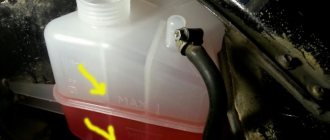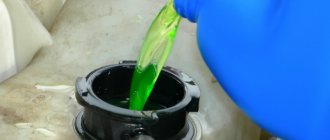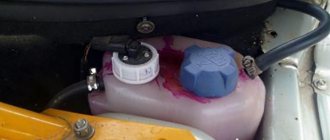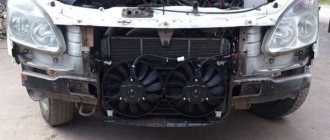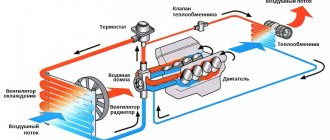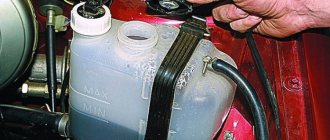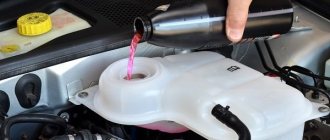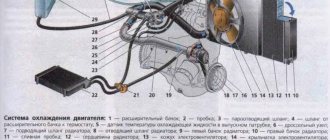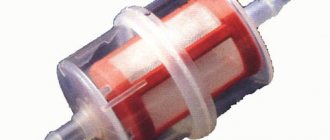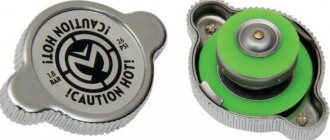As you know, a lot of heat is generated when an engine is running. Part of the energy is converted into torque, and part goes to the cylinder walls and block. To ensure that the engine operates normally, it has cooling channels. A special coolant is used inside. It could be antifreeze or antifreeze. The liquid moves through the engine channels and heats up. The antifreeze flow enters the radiator. There the liquid cools and circulates back into the block. But what to do if the system fails to cope with its task? Cleaning the cooling radiator will help. We will talk about this in our article today.
Types of operations
There are several types of washing:
- external;
- internal.
Experts recommend washing “in a complex”. This is the only way to ensure perfect cleanliness of the cooling radiator. After all, the heat exchanger takes on the entire dust blow, since it is located immediately behind the radiator grille. Also, insects, poplar fluff and other objects get into its honeycombs. All this negatively affects heat dissipation. Cleaning the interior of the radiator is no less important. After all, the liquid loses its properties over time and precipitates. If so, it forms scale on the walls. Below we will look at how to clean the radiator inside and out.
Why does the radiator get dirty?
The reason for external contamination of the radiator is obvious: dirt gets on it directly from the road. The device is located in the engine compartment and does not have special protection. In the best case, a small shield can be installed under the radiator to prevent large stones and debris from getting into the fins of the device.
During operation, car radiators become dirty both inside and outside.
There are two reasons for internal pollution:
- dirt enters the cooling system from the outside. If there are cracks in the radiator hoses or in the radiator itself and the tightness of the system is broken, then its clogging is only a matter of time;
- The radiator becomes dirty due to poor antifreeze. It's no secret that finding high-quality antifreeze today is not so easy. The market is literally flooded with fakes. Antifreeze from well-known brands is especially often counterfeited.
Both dirty and fake antifreeze contain many foreign impurities. The radiator becomes very hot during operation. Sometimes antifreeze can even boil, and the impurities it contains form scale, which impedes the circulation of the coolant. Which leads to overheating of the motor.
Internal flushing: is it necessary?
Often, car owners do not pay attention to this procedure, but in vain. After all, this operation may be necessary even for such modern cars as the Ford Focus. Cleaning the inside of the radiator removes scale and promotes better heat transfer.
But before you begin the procedure, you need to drain the old fluid. If it is not rusty in color, then you do not need to clean the radiator. In this case, Ford Focus will continue to work without interruption. But if the antifreeze has a brownish tint, things are bad. This means that the liquid has lost its anti-corrosion properties (additives are added to the composition at the production stage) and no longer performs its main function - heat removal.
External car radiator cleaner
In the past, this unit could be cleaned at most car washes. To do this, it was first dismantled, cleaning the outer surfaces. Contaminants can adhere so firmly to the surface that it becomes impossible to wash them off with ordinary detergents. Cleaning with high-pressure water pressure may be the best solution, but strong water pressure can damage the internal honeycombs, and this will lead to depressurization.
It is better to spend a small amount of money and purchase a cleaner for cleaning the radiator outside. Auto chemicals contain concentrated active substances that successfully remove long-standing dirt, salt deposits, rust, oil, bitumen and other contaminants.
For effective external cleaning you will need the following tools and products:
The car enthusiast will need distilled water to prepare the washing solution. If the water is not purified from impurities, the active substances will quickly lose their properties. For all drivers cleaning cars, cleaning the outside of the car radiator will be more difficult in this case. And you will need to use more of the drug itself.
Car owners should take note of the following products if they need external cleaning:
Cleaning the radiator inside with your own hands
So, we drained the dirty antifreeze. What should you do next? The essence of flushing is quite simple - you need to let the engine run on a third-party fluid for several minutes. And so on until scale and rust are completely removed from the system. As a liquid, you can use ordinary distilled water.
Note!
It is strictly prohibited to use tap water for internal cleaning.
It can produce scale and cause internal corrosion. Recently, motorists have been buying specialized products for cleaning the car radiator.
These drugs are mixed with distilled water in a certain proportion and act aggressively on scale. As a result, after a short period of engine operation, all the dirt accumulated inside is washed out of the radiator. Be careful!
Do not overuse the amount of cleanser. This may damage the engine cooling system. It is better to repeat the same procedure several times, with the permitted amount of acidic substance.
After the procedure is completed, the mixture is removed and clean distilled water is added. It will finally wash away the remaining acidic substance. At the final stage, new concentrated antifreeze is poured into the tank.
Flushing the radiator without disassembling
To clean the heat exchanger with your own hands, inside without removing it, liquids of various compositions are used, both commercially produced and using improvised means.
To clean a car radiator with your own hands, stores sell products produced specifically for this purpose: 3ton Super, STEP UP, Radiator Flush and others.
You can clean the heat exchanger and the entire cooling system at home with simple citric acid and Coca-Cola.
Before you start washing it yourself, you should always wait until the engine has cooled down, otherwise there is a risk of getting burned by the steam when opening the radiator cap or expansion tank.
To clean the inside of the radiator with citric acid you need:
- Make a solution based on the proportions of 100 grams of citric acid to the amount of liquid (distilled water) required to fill the engine cooling system.
- Draining, used liquid and filling, the prepared mixture needs to be driven in a car for about a week. During this time, interacting with citric acid, all contaminants inside the heat exchanger and cooling system will dissolve.
- At the end of the cleaning, drain this liquid and flush the entire system from the inside with distilled water, and add new antifreeze.
Another handy solution for flushing the radiator is Coca-Cola. Cleaning various deposits inside the radiator with Coca-Cola occurs due to the orthophosphoric acid contained in its composition. This is done like this:
- After draining the used coolant, you need to fill the entire volume of the system with Coca-Cola, previously heated, so that carbon dioxide comes out.
- If the pollution is small, then running the engine for 5–10 minutes is enough, but when the heat exchanger has not been washed for a long time, then to effectively clean it, it’s worth driving with Coca-Cola for one day.
- Next, as in all such cases, drain the cleaning liquid, rinse the entire cooling system with distilled water and add fresh antifreeze.
Do-it-yourself external radiator cleaning
Every year, motorists are faced with such a problem as poplar fluff. It mercilessly clogs the radiator honeycombs. As a result, the liquid inside is not completely cooled. The engine runs in idle mode, which is not good for the block and cylinder head. In addition, insects get onto the honeycombs. This is especially common for those who travel long distances. Insects literally dig into the honeycombs, and it is very difficult to get them out. But no matter how contaminated the radiator may be, flushing will help correct the situation. This is best done using a mini pressure washer.
Note! The radiator honeycombs (both aluminum and copper) are thin and therefore very fragile. To avoid damaging them, choose the optimal pressure on the mini-wash.
Experts do not recommend using chemicals based on aggressive ingredients for this. This can damage both the mini-wash itself and the hoses on the radiator. The outer part of the heat exchanger should be washed under low pressure of water, without chemical additives.
External radiator cleaning
While driving, a lot of dirt sticks to the outside of the radiator surface: fluff, insect bodies, etc. Getting stuck between the honeycombs, they significantly impair air flow to the heat exchanger.
There are several methods for cleaning the heat exchanger from the outside without dismantling - with water or steam under pressure, but this method is not so effective due to the difficulty of accessing the surface of the radiator. Therefore, experts advise cleaning the heat exchanger with your own hands, after first removing it from the machine.
The removed radiator is cleaned of dirt with your own hands using a regular brush, as well as water and steam.
Properly wash off dirt from the radiator with water using low pressure, on both sides, so as not to damage the soft surface of the heat exchanger.
For better steam cleaning, you will need a steam generator. By treating the radiator grill with steam and gently blowing it without deforming or causing scratches, you can more effectively clean it of dirt stuck inside the honeycomb.
If it is not possible to clean the outside of the radiator with water pressure or steam, then we do this procedure with a regular brush or brush. Having lowered the removed heat exchanger into a suitable container and pre-treated the dirt with foam, carefully wash out with a brush all the dirt that has clogged between the plates.
The fundamental design of cars has not changed for more than a hundred years. Therefore, a car with an internal combustion engine still requires an efficient cooling system. Moreover, every year it should become more and more efficient and reliable; the higher the technological complexity of the power unit, the more critical it is to comply with the temperature regime of its operation.
At the same time, no cooling system can do without a radiator, in which the liquid of the entire system is cooled. The radiator of the cooling system is a key element that ensures stable operation of the car. Therefore, maintaining the cleanliness of this unit means maintaining the stability of the entire vehicle.
Moreover, the radiator can become dirty both outside and inside. With internal contamination, the throughput of the radiator is reduced, and the coolant does not have time to cool to the required temperature. Because of this, the car engine may overheat or operate at a slightly elevated temperature, which contributes to rapid wear of the elements.
The need for cleaning arises due to the design of the radiator itself. It consists of many plates of metal material (usually aluminum or its alloys) located very close to each other. The plates themselves contain small channels through which the heated liquid moves. At the same time, cooling due to the large heat exchange area of the entire radiator structure, cooled by oncoming air.
Therefore, the efficiency of the radiator is very important to maintain a constant temperature regime of the power plant. But, the radiator is open to the oncoming flow of not only air, but also dirt, midges and pebbles. Thus, clogging the fine-mesh structure and preventing the effective exchange of heat with the atmosphere.
You should carefully prevent such contamination and periodically clean an important element of the cooling system. Don’t be afraid of this procedure; even a novice car owner can easily handle the job.
How to flush a radiator
Before flushing the radiator, you should make sure that you need to use special products for cleaning a car radiator.
To determine the degree of contamination, during the process of replacing the coolant (after draining the used material), it is worth pouring clean distilled water into the cooling system. After this, start the car and leave it running for 15-20 minutes. After this, drain the filled water again; if you find that the water has become too dirty and has excess impurities, then you should continue flushing using special cleaning fluids for flushing the radiator. Otherwise, you can add new coolant to the engine cooling system. After draining the test batch of water, it is worth filling the system again, but with the addition of cleaning additives. And repeat the flushing cycle with the engine running for at least 20 minutes. And then you should repeat the procedure again with clean water without additives. This is done to wash out possible residues of cleaning agents, which act aggressively on rubber products and can cause metal corrosion. The system is also rinsed for 20 minutes.
After all the cycles of thoroughly flushing the radiator of your car, you can fill in a fresh batch of coolant. But it is worth remembering that when filling the system, an “air” plug may form. Which will not allow fluid to circulate normally in the system. To remove excess air, you must leave the car engine running and open the radiator cap. At the same time, it is necessary to monitor the antifreeze level and periodically add it to the system.
How to clean a radiator from dirt and dust
If severe contamination of the radiator surface is detected when replacing the coolant.
It is worth the effort to clean the outer surface; it is best to do this on a dismantled unit. The radiator cleaning itself is carried out using running water from a regular hose or a specialized mini car wash. Separately, it is worth noting that the use of mini washers with a high-pressure outlet stream of water can lead to damage to the radiator if handled carelessly. The fact is that the radiator honeycombs are made of a thin sheet of metal that is easy to bend.
At this stage, it is important to remove the bulk of the contamination from large fractions that interfere with the normal circulation of air flow. There is no need to bring the radiator to factory cleanliness.
But it is worth paying attention to possible pockets of corrosion, which should be eliminated using special products that do not contain aggressive acids and solvents. Potent substances can damage the rubber and plastic elements of the radiator.
As a result, you will get a clean radiator that works with the efficiency of a new one. This procedure is recommended to be carried out at least once every two years.
HOW OFTEN DO YOU NEED TO CLEAN?
It is recommended to preventively flush the engine cooling radiator, automatic transmission, air conditioning condenser and intercooler once every 1-2 years or every 30-50 thousand km. The frequency of cleaning depends on the operating conditions of the vehicle. When driving on dirt roads and frequent off-road trips, you need to wash the heat exchangers at least twice as often.
Consequences of ignoring periodic external cleaning of the radiator:
- loss of power on a turbocharged car. A dirty intercooler increases the intake air temperature, causing the density to decrease. Less oxygen enters the cylinders, and due to the higher temperature, cooling of the cylinder walls, combustion chamber and pistons deteriorates. On gasoline turbocharged internal combustion engines, as the air temperature in the intake tract increases, the risk of detonation increases;
- The air conditioner does not work well;
- engine overheating with all the ensuing consequences;
- kicks, jolts and delays when switching.
Those who like to conquer off-road terrain in cars with automatic transmission or CVT need to monitor the cleanliness of the gearbox radiator with special passion. Often the cause of jolts, twitching, delayed shifting and accelerated wear of the clutch packs is precisely the overheating of the automatic transmission.
CAN YOU WASH WITHOUT REMOVING?
Cleaning the radiator from the outside without removing it is ineffective. Dirt, sand and small stones clog the front part of the heat exchanger, simultaneously bending the honeycombs. To push through these dirt plugs, you must first soften them, and then try to push them out at a right angle with the pressure of water under pressure. This means that even without removing the radiator from the car, you will have to at least remove the bumper, radiator grille and fans. Without all this, you will not be able to direct the stream of water as perpendicular to the honeycombs as possible, which will make flushing the radiator a waste of time. Blowing with compressed air or washing without removal can be called even more pointless if the car has a “sandwich” of an engine radiator, an air conditioning condenser, an intercooler and an automatic transmission oil cooler.
On most vehicles, removing the engine radiator does not require disassembling the floor of the vehicle. Usually, to do this, it is enough to drain the antifreeze, unscrew the engine protection, the interfering mounting brackets for attachments and the mount of the radiator itself. There are no problems with removing the intercooler. Without removing it from the car, it makes sense to wash only the air conditioner radiator. And then only if it is not very dirty, the system is working properly and is filled with refrigerant (to remove the condenser, freon needs to be pumped out, which is impossible to do with your own hands without equipment).
Car radiator design
The heat exchanger of the car cooling system passes antifreeze through itself, with the help of which excess thermal energy is removed from the engine. The liquid must be cooled due to the high thermal conductivity of the radiator’s structural material (copper or aluminum alloy) and constant air flow, for which purpose this unit is placed directly to the car’s bumper.
Engine radiator location
On the other side:
- all dust and dirt from the road gets onto the heat exchanger grilles; cleaning is necessary; the radiator can be mechanically damaged by a random stone;
- when honeycombs become clogged with dirt, the thermal conductivity of the structural material decreases;
- the inside of the tubes becomes clogged with scale and materials contained in the antifreeze, it is necessary to clean the radiator with a special liquid.
External contamination of the heat exchanger
Radiator honeycombs clogged from inside
In modern cars, in addition to the internal combustion engine, coolants circulate in the radiators of the heater and air conditioner. Therefore, for each of these components it is necessary to flush the car radiator with your own hands, and in different ways. The easiest way is to wash the exterior with a high pressure washer.
Signs of a decrease in heat exchanger efficiency
Since antifreeze reduces the temperature inside the heat exchanger solely due to air cooling, there is a dependence on the efficiency of its operation on the time of year, or more precisely on the ambient air temperature.
Scheduled flushing of the engine cooling radiator is therefore carried out in the spring, which allows you to get rid of impurities inside the system before the hottest summer season, when heat loads reach their peak.
Signs of a decrease in the efficiency of the heat exchanger for the driver are:
- increased fan speed and frequent switching on;
- problems with the stove and climate control equipment;
- antifreeze temperature sensor lit up>;
- inertia of the system to rheostat signals;
- interruptions in pump operation;
- engine overheating>;
- uneven heating of the heat exchanger (hot upper pipes, cold lower part).
In any of these cases, you will need to flush the car radiator as the most cost-effective option to fix the problem. External washing of honeycombs is vital in the presence of any amount of dirt, dust, grass, or clogged midges.
Attention: Installing a protective mesh screen inside or outside the radiator grill solves the last problem by 90%.
Radiator mesh screen
HOW TO WASH CORRECTLY SO AS NOT TO BEND HONEYCOMB?
There are several simple rules, the observance of which will ensure that the heat exchanger after washing will be clean and will not leak.
- Knock off the top layer of dirt by washing the honeycombs with clean water from the outside and inside. Cleaning should begin on the side facing the engine. Apply the cleaning compound to the radiator honeycomb for a few minutes. As a chemical, both a special cleaner for washing the outer part of the radiator from Liqui Moly and a regular engine cleaner or insect remover are suitable.
To prevent negative effects on aluminum, all chemicals must be thoroughly washed off with clean water.
Lada Priora Sedan Quartz › Logbook › Cleaning radiators and partial anti-corrosion
Today I bought a gasoline overshoe, Kerry anti-corrosion mastic and a cigarette lighter splitter. The first two components are necessary for partial anti-corrosion treatment of the “muzzle” and the outer side of the thresholds.
Due to the fact that the car's air conditioner had previously been repaired and a new heater filter installed, it was decided to carry out external cleaning of the radiators. For this purpose, they brought in this assistant. It's called "FIAC". I must say it's a good machine.
Next, the front bumper was removed. I had to sweep out a lot of debris and dust from the recesses.
By the way, it is interesting that both air guides turned out to be significantly rusty.
The left one was not installed correctly at all (is it really that way at the factory). Subsequently, upon visual inspection, it turned out that it was the same right one, but screwed in reverse. I had to work a little with a hammer and now it became left.
Next, after a small anti-corrosion treatment of the guides, two radiators (main and conduit) were cleaned using air and a hard brush. Everything became very clean and not dusty. All mosquitoes and flies were removed.
Then the anti-corrosion treatment of the front of the car was continued.
Next, the front bumper was reassembled and installed. Now there is a queue behind the thresholds. To do this, the plastic protective boxes on both sides were dismantled. Yes, in three years there has been plenty of dirt there.
Next, all debris and dirt were removed from them and after degreasing the surfaces, anti-corrosion coating was applied on both sides.
Now all that's left to do is assemble everything in reverse order.
Well, that's all, the machine is fine...
Thank you for your attention!
Don't forget to give it a thumbs up if you liked it!
It is very important for me!
Once again thank you all for your attention!
MY AIR CONDITIONER RADIATOR
In a cabin air conditioning system, a condenser is needed to cool the refrigerant before it enters the evaporator. If you do not want to pump out freon and refill the system, remove the fan, radiator grille, bumper and other elements that interfere with access to the cells. Use a soft brush to wipe off the outer layer of dust, lint and dirt. Spray an aerosol engine cleaner on the inside and outside for 5-10 minutes. Rinse off the muddy dirt with water pressure. Additionally, blow the honeycombs with compressed air and rinse until completely clean.
INTERCOOLER
After removal, be sure to check for oil inside the intercooler and in the air pipes. A small amount of motor oil is normal. But if it pours out of the intercooler, then it is necessary not only to repair the turbine, but also to clean the inside of the intercooler. A mixture of gasoline and diesel fuel works well for this type of washing.
When assembling, pay attention to the fixation of the pipes. On some cars, it is recommended to change the sealing collars during reassembly. Any leak in the compressor circuit will result in loss of power.
PREVENTION
The engine overheats if the radiator is clogged not only on the outside, but also on the inside. To check, fill it completely with boiling water. Touch the entire area of the heat exchanger with your hand. The presence of cooler areas indicates that the coolant circulation channel inside these places is clogged. Previously, we looked at how to flush the heater radiator and engine cooling system.
After assembly, filling with antifreeze and first start-up, make sure that no air lock has formed in the system. Warm up the car until the fan turns on. If the temperature arrow continues to creep up, the interior heater is blowing cold air, you need to remove the air lock.
The car needs it quite regularly. This is due to the fact that this element of the vehicle’s design is needed to maintain the operating temperature of the engine, to protect it from overheating, and so on.
During active use, the radiator begins to become clogged with debris and dirt. In this case, the heat emanating from the radiator is not completely transferred to the environment, but is returned back to the engine.
As a result, the power unit may overheat. It is necessary to clean the car radiator depending on how badly it is clogged. If this is not done, then sooner or later the vehicle will fail.
It must be said that the heater cooling radiator, the car’s automatic transmission, the air conditioner evaporator, and so on can also become clogged.
The radiator becomes clogged while using the car due to the fact that dust and debris fly into the car from the road one way or another. This part gets dirty much faster if the vehicle is driven on country roads or in areas where there is serious dust.
Insects can also get into the radiator, which later turn into a rather solid mass along with dust.
To clean the radiator without removing it, you can use ordinary water, which will clean its outer surface, but it is often not very easy to get to this part of the car.
To carry out high-quality cleaning, the radiator is often removed.
It even happens that ordinary cleaning of the outside with water turns out to be insufficient, since the dirt has settled so firmly that it cannot be removed from the surface using traditional methods.
To get rid of contamination, use a special product to clean the outside of the vehicle radiator.
As a rule, the heating radiator or air conditioner radiator is washed with running water, but in car washes this is done under quite high pressure. In this case, the operation must be performed as carefully as possible, since here it is possible to damage the honeycombs, which will simply cause a radiator leak. It will eventually lose its seal.
If salt sits on the radiator along with dirt, it should be removed from the surface of the part as quickly as possible. The fact is that the part is made of aluminum, and a saline solution can corrode it in just a few minutes. As a result, this will end in the same car radiator leak.
It is also worth noting that water is unlikely to be able to remove stubborn deposits, which means that you will have to use a special product to rid it of dirt.
There are quite a lot of chemicals developed specifically so that chemical cleaning of the radiator can be done without removing this part.
Chemical products produced by the following manufacturers are widely popular among drivers:
- Hado;
- VERYLUBE;
- Liqui Moly.
There are also universal cleaning agents on sale that can be used to clean not only dirt from the radiator of a car’s engine cooling system, but also from the entire engine.
The cost of such a substance can vary greatly - it depends on which company produced this product. In particular, the cost of one bottle, the volume of which will be about 250 ml, can reach a thousand rubles.
It is not advisable to purchase products that are too cheap, since inexpensive drugs may use too active substances, which can be as harmful as the pollution itself.
You can wash the cooling radiator of an air conditioner or internal combustion engine by removing the heat exchanger. If the contamination is not too significant, then you can use the simplest method - blow it out with compressed air, and do this from outside the car, without removing or disconnecting the radiator itself.
The sequence of actions here will be as follows.
- First you need to remove the upper front trim.
- The radiator grille is removed, which is secured in the car with four screws; in addition, it is additionally held at the bottom by three clips. The hood lock drive is also removed here.
- Now, using a special key, they remove the fastenings of the air intakes, which are located in front of the car, and also remove all the plastic elements located outside.
- Take a hose, at the end of which there should be a tube, and blow out all the radiator cells from it, after which they are washed with running water.
A car wash will be needed if you do not have a compressed air compressor and the device necessary to wash the element at hand. Workers will carefully remove the radiator and thoroughly clean it of all contaminants.
It is worth noting that it is highly undesirable to remove the radiator yourself, since it is not very conveniently located on many car models. It will be very difficult to remove it, and it will be even more difficult to return it to its place.
The heating radiator is not always clogged with dirt from the outside; sometimes dust makes its way inside. This, in turn, also leads to overheating of the motor.
To ensure that the heat exchanger becomes clogged with dirt as little as possible, experts advise changing the coolant at least once a year.
In addition, it is also advisable to flush the entire system, which is done as the antifreeze becomes cloudier.
There are various folk remedies used to flush the cooling system: some car enthusiasts advise flushing it with whey, citric acid or electrolyte solution, Coca-Cola, caustic soda, and so on. However, all of them are untested and can lead to the radiator completely corroding.
The most reliable way to clean the cooling system of all kinds of contaminants is to flush it with clean water.
The technology in this case will be as follows.
- First you need to warm up the engine to operating temperature.
- All contaminated coolant will need to be completely drained, and this is done with both the radiator and the cylinder block.
- You need to wait a little time for all this liquid to drain out of the car.
- All drain plugs are returned to their places, clean water is poured into the system from the outside and the motor is allowed to run for approximately 15 minutes.
- The motor is stopped and water is removed from the system. If it flows dirty, the operation should be repeated until clean water returns.
- Now you can add fresh coolant.
How and with what to flush the inside of the radiator?
To flush the radiator from the inside, you can use one of the following products:
- Citric acid;
- Pepsi or Cola;
- Electrolyte;
- Distilled water;
- Finished drugs;
Let's talk about each of these methods in more detail.
Flushing the cooling radiator with citric acid
1)
. As in general and with almost any manipulations with the cooling system, you need to wait until the power unit cools down completely, otherwise you can get unpleasant and, in some cases, dangerous burns from steam escaping through the radiator cap.
2)
. We prepare the solution as follows: dilute 100 grams of citric acid with the volume of water that is enough to fill the engine cooling system.
3)
. Next, we need to drain the used liquid and fill in the prepared composition instead. We've been driving the car for about a week. During this time, when interacting with acid, all contaminants inside the cooling system and heat exchanger are dissolved.
4)
. After a week, the liquid with acid must be drained, and the entire system must be rinsed from the inside with distilled water, after which we fill the cooling system with antifreeze or antifreeze.
Flushing the cooling radiator with cola (or pepsi)
1)
. We drain all the liquid from the cooling system and pour in Coca-Cola, previously heated, so that carbon dioxide does not escape from it.
2)
. If the nature of the deposits is not critical, it will be sufficient if the engine runs for 5-10 minutes. But in cases where pollution greatly burdens the system, then it is necessary to ride during the day.
3)
. Then drain the Cola, rinse it with distilled water, and then fill it with fresh coolant.
Flushing the cooling radiator with electrolyte
To flush the radiator, you can also use battery electrolyte with a density of 1.27.
1)
. In a large 10-liter bucket, mix clean water with a liter of this substance, then pour the resulting solution into the cooling system.
2)
. All trips on this day must be made with a filled radiator, which will allow it to be cleaned as much as possible.
3)
. In the evening, drain the solution and rinse the radiator with clean water, then add coolant.
Attention! I have not personally used this method, but according to reviews on the Internet, electrolyte is also an effective means for cleaning a radiator.
Flushing the radiator with distilled water
If, when replacing the coolant, you do not notice any special contamination, then it is quite possible to get by with distilled water. It is not recommended to use tap water with a large amount of salts and impurities. As an example, you can take a kettle, on which scale appears after using tap water.
1)
. Pour clean water into the radiator and start the car at idle speed.
2)
. 20 minutes after operating in this mode, drain the water and add coolant.
Ready-made drugs
Today you can find many options for special flushing fluids on sale. They can be either alkaline or acidic. They are best used according to the instructions.
Video
Cleaning the radiator from the outside using special chemicals
On sale today you can find automotive chemicals for a wide variety of purposes, in particular, there are substances that allow you to quite effectively flush the cooling system the first time. However, it is worth saying that not every tool allows you to do this efficiently. There are substances that seriously disrupt the operation of both the engine and the car as a whole.
In this case, the rule works well - the cheaper the product, the worse it interacts with the radiator. It is best to use products for washing that are offered by world-famous companies producing automotive chemicals, which have also managed to gain a positive reputation.
These products are quite different in composition and purpose. In particular, some of them are added to coolant to act as an additive and prevent the formation of scale and rust.
In addition, you can find chemicals on sale that allow you to remove antifreeze leaks from the pipes or from the radiator. However, it should be used as carefully as possible, since it is quite viscous and its careless use leads to clogging of the tubes and thin hoses of the system.
Based on a number of external signs, you can determine that the radiator is starting to clog.
- The fan cooling the engine began to start quite often, and it does this not only at idle, but also while driving.
- The motor starts to heat up very quickly. Moreover, when the expansion tank of the heating system is opened, coolant flows out of it.
- The lower part of the radiator, together with the lower hose, is at normal ambient temperature, but the upper hoses related to the cooling system are very hot.
- The stove heats the interior very slowly.
The outside of the structure can be cleaned using a special spray. To do this, spray this substance onto the radiator grille and leave it for about five minutes.
Take an ordinary garden sprayer and wash off this liquid. This should be done several times until the dirt is washed off from its surface.
A garden sprayer is used to avoid damaging the honeycomb of the device. They are quite sensitive to various kinds of loads, so they can burst under strong pressure.
This sprayer does not create too much pressure, so it can be safely used.
It is worth noting that cleaning the radiator yourself is unlikely to help completely get rid of dirt, but it can remove the bulk of the debris.
This will allow you to drive normally in the future and not be afraid of overheating or even complete engine failure.
The operational parameters of a car depend not only on the condition of its power unit and chassis, but also on the performance of the cooling system. To a certain extent, this is ensured by the use of high-quality coolants. Otherwise, deposits quickly appear on the inner walls of the heat exchanger, which leads to a loss of its heat-conducting properties.
When does the cooling radiator need to be flushed?
Clear signs that the cooling system needs cleaning:
- the cooling fan turns on more often, and not only at idle, but also while driving;
- the engine heats up quickly;
- Antifreeze is thrown out of the expansion tank when heated;
- the bottom of the radiator and the lower pipe are cold, the upper hoses of the cooling system are hot;
- the heater in the car does not heat well;
Over time, scale accumulates in the cooling system. When draining the coolant from the radiator, pay attention to the content of sediments, particles and color changes in it.
A cloudy liquid containing particles of an unknown substance indicates that there is probably scale on the walls of the system. Although not always, even clean liquid indicates the good condition of the radiator from the inside.
A sealant can also get into the coolant, which can be used to seal small cracks and holes. Oil may also get in here.
Types of cooling system cleaning
Cleaning the car cooling system is divided into internal and external work.
Interior work
. Internal cleaning involves eliminating traces of corrosion, engine oil residues, coolant (antifreeze or antifreeze), as well as accumulated scale.
Exterior works
. Consists of external cleaning of all components of the cooling system. That is, we wash off dust, dirt, sand, etc. from it. It is also necessary to thoroughly wash off any insects adhering to it from the radiator honeycomb.
When should you wash?
Before cleaning your car radiator, you should carry out a simple inspection that will allow you to assess the degree of contamination:
- Assessing the effective operation of the cooling system.
- Checking the condition of the coolant (coolant).
- Inspection of the inside of the heat exchanger.
The first thing that should alert the car owner is the frequent activation of the forced cooling fan. The reason is a decrease in the cooling area, the fluid flow is reduced due to the fact that the radiator tubes are clogged with foreign deposits. It is also possible that the outer plates become clogged with dust or insects.
When draining the coolant, be sure to pay attention to the presence of foreign inclusions in it, as well as changes in its color. Scale on the walls of the radiator unit is indicated by sediment or small particles.
A visual inspection of the inside of the heat exchanger can also determine the presence of scale. It is performed using an electric torch with the neck plug removed. However, this method can hardly be called effective, because the sediment accumulates to a greater extent at the bottom. Therefore, any motorist interested in the question of how and when to clean a car radiator should understand that examining the upper part will not reveal the true condition of the unit.
Experienced car owners wash the heat exchanger even in the absence of the listed signs. They carry out the procedure on average every 20 thousand kilometers, but the interval can be shifted depending on the quality of the coolant. If you have already had to clean the radiator assembly several times, then creating a work schedule will not be difficult.
Radiator malfunctions
The most common heat exchanger malfunctions are:
- Clogging with rust, scale and other debris inside the core.
- Contamination of the outside of the heat exchanger honeycomb with fluff, etc.
- Clogging of the duct from the inside in the radiator pipes with debris.
The following factors will indicate the occurrence of such malfunctions:
- Frequent activation and operation of the fan at high speeds, even when driving at high speed.
- Constant twitching of the temperature sensor needle or its indication that the temperature of the cooling system is too high.
- During the cold period, the heating of the car interior is poor.
You should not ignore these factors, which can lead to engine overheating, which will be signaled not only by the sensor, but also by the expansion tank cap torn off by steam, but clean the heat exchanger from the inside or outside, depending on the type of contamination.
Do it yourself: how to clean a dirty car radiator from the inside?
If you can perform external cleaning of the heat exchanger directly on the machine, without resorting to dismantling it, then it is necessary for internal washing. The withdrawal process is accompanied by the following points:
- Place a suitable container under the radiator valve.
- Unscrew the neck cap.
- Open the valve on the cylinder block and drain the coolant.
To clean the insides of the heat exchanger, you need to direct a dense stream of water into its neck. All foreign particles and sediment will exit through the lower pipes. The procedure should be repeated several times. In case of severe contamination, the use of special cleaning liquids is permissible.
After flushing and installing the radiator, you need to get rid of air pockets in the system. To do this, start the engine and let it run for about 15 minutes with the neck of the heat exchanger open, then turn on the heater to maximum. A simpler method involves placing the front wheels of the car on a hill and then starting the engine for 2-3 minutes.
lucky09-11 › Blog › How to flush a cooling radiator without removing it - cleaning the outside and inside
In the summer, many motorists experience engine overheating.
Most often this is due to contamination of the cooling radiator; accordingly, the malfunction is eliminated by cleaning and washing this part. But how to solve the problem without removing the radiator? We will answer this question in detail below in the article. A few words about the design of the radiator The radiator is a heat exchanger container for coolant that constantly circulates in the engine. Those. The part's task is to cool the liquid, so it is located between the engine and the radiator grille. The latter ensures air flow to the radiator while the car is moving.
The radiator is based on copper or aluminum channels (tubes) arranged horizontally. All channels are interconnected by so-called honeycombs that provide heat removal. Since when the car moves, dust and all kinds of debris penetrate through the radiator grille along with the air, the space of these honeycombs becomes clogged over time. As a result, the efficiency of heat removal is greatly reduced, which leads to overheating of the engine. Therefore, our task is to remove dirt clogged in the heat-dissipating honeycombs.
We steam the radiator from the outside - why do we need compressed air and water? Ideally, it is advisable to dismantle the radiator, which will allow for high-quality cleaning even in the most inaccessible areas. But if you don’t have time to dismantle it, you can try to solve the problem without removing it. The simplest cleaning option is to remove dirt with compressed air or pressurized water. In this case, you will need a compressor or a Karcher-type mini-wash.
It must be said that many car models, for example, the VAZ 2110, have an electric fan that cools the radiator on the engine side. Therefore, before starting cleaning, it is necessary to dismantle the fan. To do this, disconnect the power connector from the fan, and then unscrew the bolts of the panel on which the fan itself is attached. This will give you access to the radiator.
Washing with water or cleaning with compressed air is carried out on the engine side. Try, if possible, to direct the jet perpendicular to the plane of the radiator. Do the work slowly, smoothly moving a stream of water or air over the surface of the part. You should not have any untreated areas. The effectiveness of such cleaning, of course, is not one hundred percent, but it allows you to get rid of most of the adhering dust, insects and other similar dirt.
If you don't have the right equipment, you can use a brush attached to a long stick and a special cleaning agent such as Kuhler Aussenreiniger. The product should be applied to the surface of the part using a brush or spray, where possible. After a few minutes, the surface of the radiator should be rinsed with low pressure of water, for example, from a hose. According to manufacturers, such cleaning products do an excellent job of removing lubricants, as well as adhered dirt, insects and other debris.
To better clean the radiator, you should remove the grille and other elements that block access to it. This will allow you to wash with gasoline and clean with a brush. As a result, you will be able to remove not only dust and insects from the surface of the part, but also adhering tar. Using this principle, not only the engine cooling radiator is cleaned, but also the radiator of the stove or air conditioner. But due to difficult access to these parts, they will have to be completely dismantled. Keep in mind that in some car models, access to the radiator is so closed that it is simply impossible to clean it from the outside without removing it.
What to do if cleaning the outside does not help Problems with engine overheating may persist even after cleaning the radiator outside. The fact is that its clogging occurs not only outside, but also inside - scale, sediment and other deposits form on its walls. This also significantly affects the efficiency of liquid cooling. The problem can be solved by flushing the cooling system.
To make sure that the system really needs flushing, drain a small amount of coolant into a small container. If there is sediment, impurities and dirt in it, then washing is definitely necessary.
Internal cleaning is faster and easier than external cleaning, since it is carried out chemically using special means. For example, you can use:
The cleaning process looks like this:
The engine needs to be started and warmed up so that it is warm, but not too hot. Then the engine should be turned off and a special agent should be poured into the radiator. As a rule, 10-12 liters of coolant require 250 ml of product. The manufacturer indicates the exact ratio of the product and coolant on the packaging. Start the engine and turn on the interior heating. Let it idle for 10 minutes, then turn it off. Drain the coolant by opening the tap or unscrewing the plug located at the bottom of the radiator. Some car models, for example, VAZ 2114, have a generator located opposite the drain hole. Therefore, when draining, it must be covered with film or a piece of rubber. Some cars have an additional drain plug on the engine; by unscrewing it, you can completely drain the fluid from the system; When all the fluid has drained, fill the system with water, then start the engine and let it run for a few minutes. Then turn off the engine, drain the water and add new coolant.
What cleaning products are used?
Manufacturers of auto chemicals have developed a fairly wide range of products for car care. Many companies offer special products for cleaning the radiator assembly of the cooling system. Products under the following brands differ in quality:
- Liqui Moly.
- Hi-Gear.
- Kuhler-reiniger.
The price of these products is quite high, but the effect of their use will cover all expenses. For those who do not yet know how to properly clean the radiator of their car, it should be noted that inexpensive preparations not only cope poorly with the task, but can also harm the heat exchanger. As an alternative, some use the domestic product Antiscale.
Folk remedies
Craftsmen claim that they managed to achieve a positive result without much expense using available means:
- Pepsi-Cola.
- Whey.
- Caustic soda solution.
- Weak electrolyte solution.
The use of serum has been practiced by drivers since the days of the absence of auto chemicals. It is poured into the radiator and driven for about 20-30 km, after which the solution is drained and the insides are washed with water. With the advent of Coca-Cola, craftsmen involved this product in the process. Fill it in and let the engine run for 15 minutes.
The advisability of using caustic soda raises some doubts, since its elements can not only remove plaque, but also destroy metal parts. The same attitude among specialists is caused by the use of electrolyte, the nature of which is too aggressive and can cause harm to rubber products.
Citric acid is more suitable as a product; 60-100 g are needed per bucket of water. These alternative substances eliminate the need for dismantling work, but the products of their activity in the form of individual particles can interfere with the functioning of the thermostat.
Store-bought products for flushing the engine cooling system
Automotive stores offer a large selection of modern chemicals for cleaning the cooling system. Modern drugs are produced, which can be based not only on acidic or alkaline compounds, but also on neutral ones. Two-component products are also available. Most products are available in the form of special additives for antifreeze. The most popular auto chemicals of this type are:
- Hi-Gear Radiator Flush – 7 minute is produced by an American company. The composition does not contain aggressive acids, which avoids subsequent neutralization of the treated channels. After cleaning, the performance of the radiator increases to 50%. Processing time – no more than 7 minutes.
- LAVR Radiator Flush Classic - used in any car. It is highly effective, increasing the life of the pump, cleaning the thermostat and prolonging the operation of antifreeze by 40%.
- Bizol Kuhlerreiniger - designed to remove all contaminants. The advantage of the product is its maximum neutrality towards plastic, rubber and other non-metallic elements.
If in doubt, you can contact professionals who will perform the processing for an additional fee.
conclusions
The main difficulty of cleaning lies in the nature of the deposits on the inner surface of the heat exchanger. Anyone who is interested in how to clean the radiator of a personal car must know the fact that corrosion and scale are effectively removed by solutions with an acidic environment, and decomposition products of oil-fat antifreeze are removed by alkaline compounds.
It is possible to increase the interval between procedures only if you use a high-quality liquid that contains additives that prevent the formation of harmful sediment. It is highly undesirable to purchase a dubious product - this can lead to expensive repairs of the entire engine.
Need for cleaning
Car owners use current flushing methods in practice when identifying channel contamination and before completely replacing antifreeze. In a cooling system, connecting pipes are considered to be the most vulnerable to clogging. Due to contamination, the channels become clogged and eventually collapse under stress. The main contaminant of the ducts is the scale of salts formed as a result of high-temperature exposure. It grows on the inner surface of the tubules and reduces the bore diameter. If it is not removed, the efficiency of the system is significantly reduced, the motor overheats and may fail. The degree of overheating is indicated by a burning red light indicator on the dashboard. You can get rid of contaminants using distilled water in the following way:
- the engine must be cooled down, so after stopping you will need to wait 15-20 minutes;
- place an open container under the drain hole and unscrew the plug so that the remaining used antifreeze drains out;
- when the liquid stops flowing, tighten the plug and pour distillate into the system in a volume equal to the antifreeze removed;
- add the required amount through the expansion tank;
- we start the internal combustion engine for 15-20 minutes at idle speed, it is also permissible to drive silently;
- turn off the engine and after a few minutes drain the resulting liquid;
- If significant water contamination is detected, the procedure is repeated.
After flushing the cooling system with your own hands and removing scale, you can fill the cavity with clean coolant. The advantage of the technique is the availability and safety of processing. Purchasing distilled water is not difficult.
What should not be done to flush the cooling system?
Here's what it's strictly not recommended to put into the system:
- tap water. It contains mineral salts that form limescale. Any attempt to flush the system with such water leads to even greater clogging;
- vinegar essence. Above we talked about 9% table vinegar. But it is strictly forbidden to pour concentrated acetic acid into the system. It will quickly corrode hoses, gaskets and other rubber elements, and the system will lose its tightness.
Types of batteries?
We first need to decide on the types of radiators in order to take into account their features before washing the batteries. At the same time, you need to come to terms with the fact that all batteries will have to be cleaned sooner or later - regardless of what they are made of.
When reassembling, a welding machine may be needed.
When reinstalling, you can use a sealant (FUM tape, for example).
Advice! Blowing and flushing of radiators is carried out only at the end of the heating season.
How to prevent system contamination
The engine cooling system will become dirty in any case. The car owner can only delay this moment. To do this, you should use only high-quality antifreeze purchased from a certified store. Yes, such liquid will cost more. But this is the only way to avoid premature clogging of the system.
So, if the driver wants the car’s engine to work properly, he should carefully monitor the cleanliness of the engine cooling system. If this is not done, you can forget about normal operation of the car.
Preparing for washing
Before washing the radiator, you must first do the following:
- It is better to start such flushing before the start of the heating season - it is advisable to choose a day when housing services have already purged the heating main, but have not yet turned on the water. The ideal option is if you agree with all your neighbors on the riser about a one-time cleaning of the radiators in their apartments. So you definitely won’t give any chance to the pieces of dirt that move back and forth along with the water.
- Prepare a container where the remaining water from the heating main will flow after dismantling, first place it in the right place
- Use a suitable mechanic's tool to remove the radiators. Remove them from the pins.
- All plugs must first be removed from cast iron batteries.
- It is better to clean it in the bathroom. You need to prepare it for this: lay a rag inside so as not to knock off the enamel layer, and put a special mesh over the drain hole. This is necessary to prevent large particles of dirt from clogging it.
Advice! If the risers in an apartment building are clogged, then there will be little benefit from flushing the radiator - dirt will again, after a while, accumulate in it. It is necessary to negotiate with neighbors about comprehensive purge of the main line.
How to flush the cooling system: tips and tricks
Flushing the cooling system is a procedure no less important than other scheduled work. If this is not done in time, then gradually accumulating scale and dirt will clog the radiator channels, which, in turn, are already quite thin. The consequences could be dire. Subsequent repairs will cost significantly more than regular scheduled maintenance. Today we will talk about how to flush the engine cooling system, how to do it and what solutions it is better not to resort to.
How to flush the engine cooling system
We have figured out when to resort to the procedure. It remains to find out what can be used. There are a lot of funds and, according to tradition, they are divided into specialized and folk ones. We will look at both.
Factory remedies
Factory ready-made solutions are the best way to flush the engine cooling system. Such products, as a rule, have the necessary composition that will get rid of unnecessary deposits and will not have a detrimental effect on car parts.
Specialized liquids are divided into several types:
- neutral: they do not contain aggressive components, so too large and old deposits are washed off with less efficiency, such solutions are ideal for periodic prevention;
- alkaline: the name speaks for itself, such liquids contain alkalis and they ideally cope with organic contaminants;
- acidic: it contains an acid that quickly and effectively breaks down inorganic deposits;
- two-component mixtures: both alkalis and acids are present here. The products belong to the universal category.
Why do you need to flush the cooling system?
The main element of the cooling system is the radiator. Several hoses are connected to it. Through them, antifreeze enters the engine jacket, which is a collection of small channels. Circulating through them, antifreeze removes heat from the rubbing parts of the engine and returns to the radiator, where it gradually cools.
If the circulation of antifreeze is disrupted, the engine will overheat and seize. To eliminate such a breakdown, major repairs will be required. Timely flushing of the cooling system avoids disruption of antifreeze circulation and protects the engine from overheating. It is recommended to flush the system every 2 thousand kilometers.
Why does the cooling system become dirty?
Here are the most common causes of contamination of the cooling system:
- scale Antifreeze, circulating in the engine, heats up to very high temperatures. Sometimes it even boils. When this happens, a layer of scale appears on the walls of the radiator pipes, which becomes thicker every year and eventually begins to interfere with the normal circulation of coolant;
- poor quality antifreeze. About half of the coolants on the shelves today are fakes. Most often, well-known brands of antifreeze are counterfeited, and often only a specialist can recognize a counterfeit. Fake antifreeze contains a lot of foreign impurities that clog the cooling system;
- antifreeze aging. Even high-quality coolant can exhaust its life. Over time, tiny particles of metal from the rubbing parts of the engine accumulate in it, which leads to a change in its chemical composition. After this, it can no longer effectively remove heat from the motor. The only solution is to replace it after flushing the system;
- violation of tightness. As mentioned above, the cooling system has a lot of hoses and tubes. Over time, hoses can crack or burst in the cold. The steel tubes in the radiator are often subject to corrosion. As a result, the tightness of the system is broken, and dirt gets into it through cracks, changing the chemical properties of the antifreeze and interfering with its circulation.
